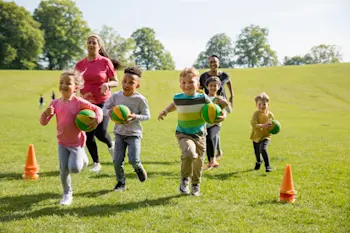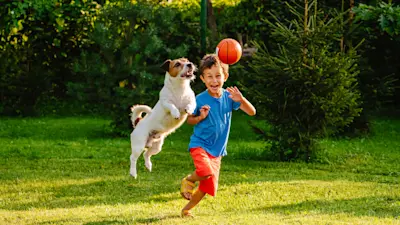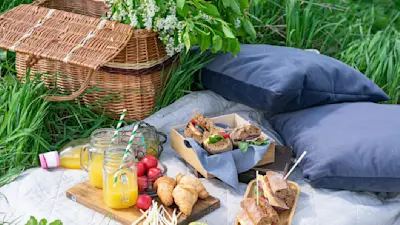Create the ultimate obstacle course

This summer we’re showcasing our favourite free activities to grow a child’s mind and body.
Have you ever created an obstacle course in your home or garden? Creating a garden obstacle course for your children is a fun and engaging way to get them outside and active. My childhood memories are filled with elaborate structures made of cardboard boxes, chairs, cushions and blankets that became a source of amusement for hours. Once you teach your children how to get started they’ll be able to create their own and entertain family and friends throughout the holiday.
Read on for our guide to creating the ultimate obstacle course.
5 steps to creating your first obstacle course:
Choose a location: A flat, open area in your garden would be great but an obstacle course can be adapted to any space that you’ve got.
Plan the course layout: An obstacle course needs a start and a finish and if you’re feeling competitive, a stopwatch, to see who can complete the course in the fastest time. You’ll need objects to climb on, balance along, crawl through, with activities to do along the way. Sketch out a rough plan of the course with your children.
Gather materials: Think about obstacles that you can use for climbing - A bench, a strong cardboard box, a pillow mountain? If you have a garden slide, climbing frame or trampoline these could all be incorporated into your challenge. Use skipping ropes, logs or rocks for balancing and large boxes are perfect for tunnels.
Set up the course: Place the obstacles around, walk through the activities and check that everything is safe.
Create the story: Imagination brings everything to life. For the ultimate obstacle course we need to take our children into different worlds. Set the scene - that skipping rope laid on the grass is actually a tightrope above a fiery volcano. Those stepping stones are the backs of turtles in shark infested waters. I love to get ideas from my children. They see objects in such an imaginative way. Why not get your children involved in creating stories for the rest of the course.
Incorporating learning into outdoor play
At Explore Learning we love finding ways to help children learn secretly - especially in the summer when we’re taking a break from school. There are lots of subtle ways that you can include maths and English into an obstacle course alongside developing strength and motor skills.
Including maths in your obstacle course
I love to slip a bit of maths into any outdoor play; counting, measuring and time are all easy to include.
Counting - As part of the course you may need to throw a ball against the wall and catch it 10 times or count how many steps it takes between one obstacle and another.
Measuring - Have a target as part of the course and measure how closely you can get a ball to the target. Use a measuring tape and record your score.
Time - Use a stopwatch and see how many times you can hula hoop in 30 seconds or record how long you can stay standing on one leg. Try and estimate the time that it takes you to do the whole course. This all helps build a concept of time.
Including English in your obstacle course
Try these fun and subtle ways of including a bit of English learning into the course:
Storytelling - We already mentioned creating a story around your obstacle course; this is a great way to include descriptive language and narration. Take it in turns to describe different parts of the course, e.g. ‘You’re approaching the deep, dark tunnel full of slimy toads can you feel them?’
Alphabetical order - Include some books in an area of the course. Challenge children to put the titles into alphabetical order. Next time around they could do it by author or illustrator or the first word on the first page. You can keep varying the task each round.
Spelling - Peg letters onto your washing line and challenge your children to make a word - this can easily be adapted for any age group starting with spelling their name or simple three letter words up to tricky words like ‘obstacle course’.
Handwriting - Get children to record times and measurements on a clipboard as they complete different activities.
Building strength, gross and fine motor skills
We all want our children to be happy and healthy; encouraging them to do some physical activity everyday is so important for their growth and development. Obstacle courses naturally include activities that build strength alongside gross and fine motor skills. By creating a course yourself, you can easily adapt to your child’s physical needs and abilities. If tasks appear easy you can add more layers of challenge or remove as needed.
Developing gross motor skills
Any activity that gets children moving and using their large muscle groups can help them develop their gross motor skills. Obstacle courses are a perfect way of doing this.
Running and jumping - Include space to jump or run from one section to another
Crawling and climbing - These build strength in the large muscle groups and add to the fun of an obstacle course.
Move like an animal - Challenge your children to move like a crab, a dog, a frog or a horse as they go around the course
Dance and hula - Dance or hula hoop to music as they go or have a section where they need to complete some dance moves before they move on.
Developing fine motor skills
Any activity that requires children to use their hands and fingers in a precise manner can help develop their fine motor skills. In an obstacle course you could include some of these activities to help with hand strength, dexterity and hand-eye coordination.
Egg and spoon - Hold an egg and spoon throughout the course or balance a small toy on your head
Tying shoelaces - A great task to include amidst the obstacles is some trainers with laces that need tying.
Beads in a bucket - Put out a bucket of mutli-coloured beads and get children to pick out beads of a certain colour. Perhaps there are 10 blue beads in the pot and they have to find them all.
Keys and locks - Include unlocking a door or padlock as part of the challenge, perhaps the key is hidden somewhere and has to be found first.
Dress up challenges - Find a top with buttons that they have to put on and do up all the buttons as part of the course. For older children try putting on gloves first and then doing up buttons for an extra challenge.
Are you feeling ready to give it a go? Remember the number one rule… You have to do it too! Throw yourself into the challenge, laugh and make a fool of yourself. Your children will be so excited to think of new activities to include once they know you’re joining in.
For more summer learning activities check out our resource hub or pop along to an Explore Learning centre near you to collect a free summer activity pocket book.







